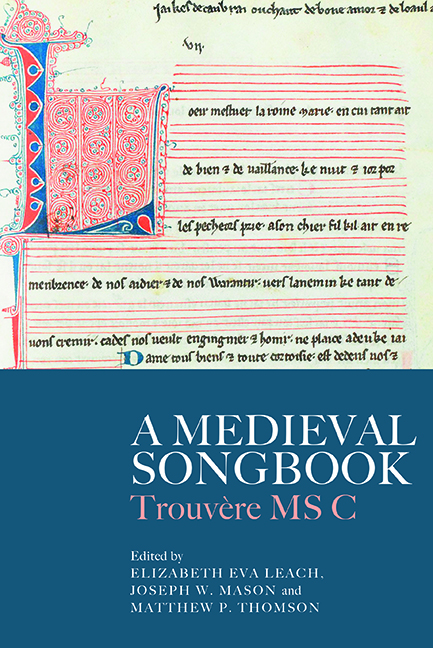Book contents
- Frontmatter
- Contents
- List of Illustrations
- List of Music Examples
- List of Tables
- List of Contributors
- Acknowledgements
- Abbreviations
- Editorial Practices
- Introduction
- Chapter 1 The Trouvère Manuscripts of the Burgerbibliothek Bern
- Chapter 2 The Lorraine Repertoire of C
- Chapter 3 Chansonnier C: Contents, Stemmatic Position, Particularities
- Chapter 4 A Note on the Decoration of C and its Artistic Context
- Chapter 5 Author Ascriptions and Genre Labels in C
- Chapter 6 Common Exemplars of U and C
- Chapter 7 Shared Small Sources for Two Early Fourteenth-Century Metz Chansonniers?
- Chapter 8 The Legacy of Thibaut de Champagne in C
- Chapter 9 Strategies of Appropriation in Jacques de Cambrai's Devotional Contrafacts
- Chapter 10 Jeux-Partis and their Contrafacts in C
- Chapter 11 C and Polyphonic Motets: Exemplars, Adaptations, and Scribal Priorities
- Appendix: List of Songs in C
- Bibliography
- Index of Sources
- Index of Songs
- General Index
- Studies in Medieval and Renaissance Music
Chapter 11 - C and Polyphonic Motets: Exemplars, Adaptations, and Scribal Priorities
Published online by Cambridge University Press: 26 May 2022
- Frontmatter
- Contents
- List of Illustrations
- List of Music Examples
- List of Tables
- List of Contributors
- Acknowledgements
- Abbreviations
- Editorial Practices
- Introduction
- Chapter 1 The Trouvère Manuscripts of the Burgerbibliothek Bern
- Chapter 2 The Lorraine Repertoire of C
- Chapter 3 Chansonnier C: Contents, Stemmatic Position, Particularities
- Chapter 4 A Note on the Decoration of C and its Artistic Context
- Chapter 5 Author Ascriptions and Genre Labels in C
- Chapter 6 Common Exemplars of U and C
- Chapter 7 Shared Small Sources for Two Early Fourteenth-Century Metz Chansonniers?
- Chapter 8 The Legacy of Thibaut de Champagne in C
- Chapter 9 Strategies of Appropriation in Jacques de Cambrai's Devotional Contrafacts
- Chapter 10 Jeux-Partis and their Contrafacts in C
- Chapter 11 C and Polyphonic Motets: Exemplars, Adaptations, and Scribal Priorities
- Appendix: List of Songs in C
- Bibliography
- Index of Sources
- Index of Songs
- General Index
- Studies in Medieval and Renaissance Music
Summary
C has long dwelt on the edge of scholarly, and especially musicological, consciousness. Despite concentrated work by Paola Moreno, Nicolaas Unlandt, and others, this manuscript has struggled to make much of an impact on the creation of a musicological picture of song in the thirteenth or early-fourteenth centuries. In seeking to fix this problem, the contributions to this volume return repeatedly to one of the most direct ways of getting to know a manuscript and integrating it into scholarly discourse, asking two essential questions: what kinds of material did the scribes and compilers of C have access to and what were their priorities in selecting, adapting, and copying songs?
The choice in this chapter to examine the connection between C and motets may seem a strange one. C is not a manuscript well-known for its polyphonic connections; interactions with motets seem to have been a less central concern for the scribes and compilers of C than for those of other contemporary manuscripts of trouvère song. The importance of C 's song-motet interaction therefore resides chiefly in the valuable opportunity it presents to answer the two essential questions posed above; the actions of C's scribes – selecting, adapting, and copying the motet-related material to which they had access – afford useful comparisons with other manuscripts and help to clarify the habits and priorities of those creating C.
Before engaging with C's specific interactions with motets, it is important to consider the ways in which other manuscripts of trouvère songs are connected with the polyphonic motet. On the most basic physical level, there are several manuscripts which contain both trouvère songs and motets. Among manuscripts that share C’s eastern provenance, I is key, but manuscripts with provenance in northern France include M, T, and a. Manuscripts of motets and songs also share strategies of manuscript organisation: a number of motet manuscripts, including W2 and Ba, organise their motets alphabetically by initial letter. This organisational strategy is also found in a small number of manuscripts of trouvère song, including C and O. On more specifically musical levels of connection, Mark Everist and Gael Saint-Cricq have extensively considered how motets use musico-textual forms more usually associated with songs, with Everist placing special focus on rondeau form and Saint-Cricq on pedes-cum-cauda (AAB) forms.
- Type
- Chapter
- Information
- A Medieval SongbookTrouvère MS C, pp. 192 - 210Publisher: Boydell & BrewerPrint publication year: 2022



